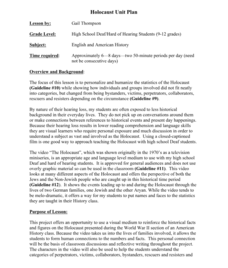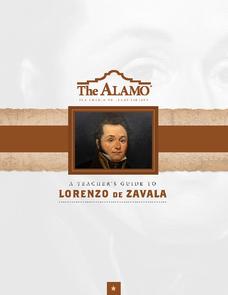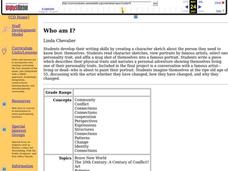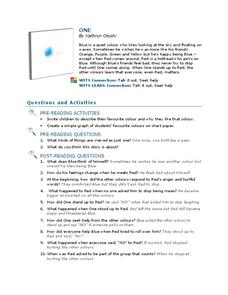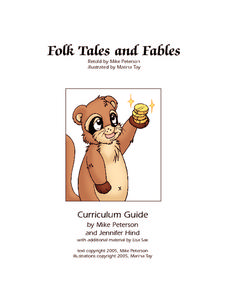University of California
Plankton
Plankton: so much more than just a SpongeBob character. Three different activities have kids looking at both phytoplankton and zooplankton in pictures, as well as collecting their own samples (depending on your access to a saltwater...
Curated OER
Full Esteem Ahead
Young learners who feel good about themselves will fare better in the long run than those who do not have a high level of self-esteem. Introduce youngsters to what it means to like themselves. Discuss positive characteristics and...
Curated OER
My Antonia: Problematic Situations
Introduce your class to the characters from My Antonia by Willa Cather in a unique way. Given a hypothetical situation about an atomic bomb shelter and a list of character descriptions, pupils must decide which characters get to...
Western Illinois University
Holocaust Unit Plan
Would it have been you? Scholars investigate the horrors of the Holocaust during World War II. They view, interpret, and analyze the video The Holocaust to gain insight into who exactly was impacted by the events Europe. They then...
Curated OER
Plankton Parade
Plankton isn't just a tiny cartoon character, it's also a very important food source for animals around the world. Budding scientists discuss the types and functions of plankton, including where they are found, how they are caught, and...
The Alamo
A Teacher’s Guide to Lorenzo De Zavala
Who was Lorenzo de Zavala to the Texas Revolution, and how did he change the Alamo? Find out using an educational resource that asks learners to fill out graphic organizers and respond to short-answer questions to further solidify their...
Curated OER
Speak What We Feel, Not What We Ought to Say
High schoolers examine and create their own interpretation of a particular character from the play, King Lear. They read the speeches, write a paragraph about their character, and present a short performance of their scene.
Curated OER
Who am I?
Students practice their writing skills by creating a character sketch of themselves. After viewing portraits, they select one personality trait and put their own picture into the painting of their choice. They include a conversation with...
Curated OER
Twain: An American Humorist
Students examine American humor and character through analysis of works by Mark Twain. In this cross curricular lesson, students develop a definition of American humor and determine how and why some consider Twain the 'first truly...
Curated OER
Teaching Money
Students identify coin/money values, write amounts of money and calculate change. The poem, "Smart" by Shel Silverstein is used in this lesson.
Curated OER
What is the Character of Maine?
Learners create an individual portfolio using assignments from a unit on the character of Maine. They choose two of the best assignments from each of four chapters studied and then write an essay or create a magazine which synthesizes...
Curated OER
"Rivers of Change"
Third graders research the Los Angeles River Basin and how it has changed over time.
Curated OER
Literary Element: Character
In this language arts worksheet, young scholars focus upon the characters of a novel and take the time to discuss this literary element.
Curated OER
Hero Traits
Eighth graders explore the concept of serving the common good. In this service learning lesson, 8th graders brainstorm a list of real-life heroes and create charts displaying how the actions of the heroes affected others.
Curated OER
One
First graders listen to the story One and design a favorite color graph. For this language arts lesson, learners answer comprehension questions and discover the importance of standing up for a friend. They complete a worksheet about...
Facing History and Ourselves
Citizen Power Makes Democracy Work
Eric Liu's formula "power plus character equals citizenship" and his three strategies to making change happen model for high schoolers how to develop citizen power, how to get involved and participate to make democracy work. Class...
EngageNY
Grade 10 ELA Module 1: Unit 2, Lesson 12
As the class concludes its close reading of “The Palace Thief,” groups consider how the narrator's character has changed throughout Ethan Canin’s short story.
EngageNY
Grade 12 ELA Module 1: Unit 1, Lesson 16
Class members discuss Chapter 13 of The Autobiography of Malcolm X and use evidence from their character development worksheet to support an analysis of how Malcolm X and attitudes toward him and his teachings are changing.
Weekly Story Book
Folk Tales and Fables
Pages and pages of engaging activities, worksheets, and writing projects on teaching folktales and fables await you! You don't want to miss this incredible resource that not only includes a wide range of topics and graphic...
Curated OER
Blogging to Create a Community of Writers
One of the keys for successful teaching is connecting curriculum to real-life experiences. This lesson on blogging does this, by making writing, revising, and publishing a reality. Pupils create a character for a story, write about their...
Curated OER
Creating Transitions
Fourth graders analyze the use of transitions in text. In this transitions lesson, 4th graders determine how and why a transition is used at a specific time in a piece of writing. They show transitions by using movements before...
Curated OER
Classroom Fun with Flat Stanley
Complete a series of activities based on the Flat Stanley books in this literature study instructional activity. Introduce the book with a discussion of supernatural qualities, then learnerscan create character webs, write news articles,...
Curated OER
Scribbleboy
Fifth graders are introduced to the text, SCRIBBLEBOY, discussing the cover page for clues to the genre. They discuss the ordinary surroundings contrasted by the graffiti and the words and phrases used to provide information about the...
Curated OER
The "Me" Decade: 1970
High schoolers view the video on Mary Tyler Moore Show. They discuss what they notice about the treatment of Mary Tyler Moore's character in the show. Students listen to a lecture covering notes on web diagram, such as: Fads, fashion,...



